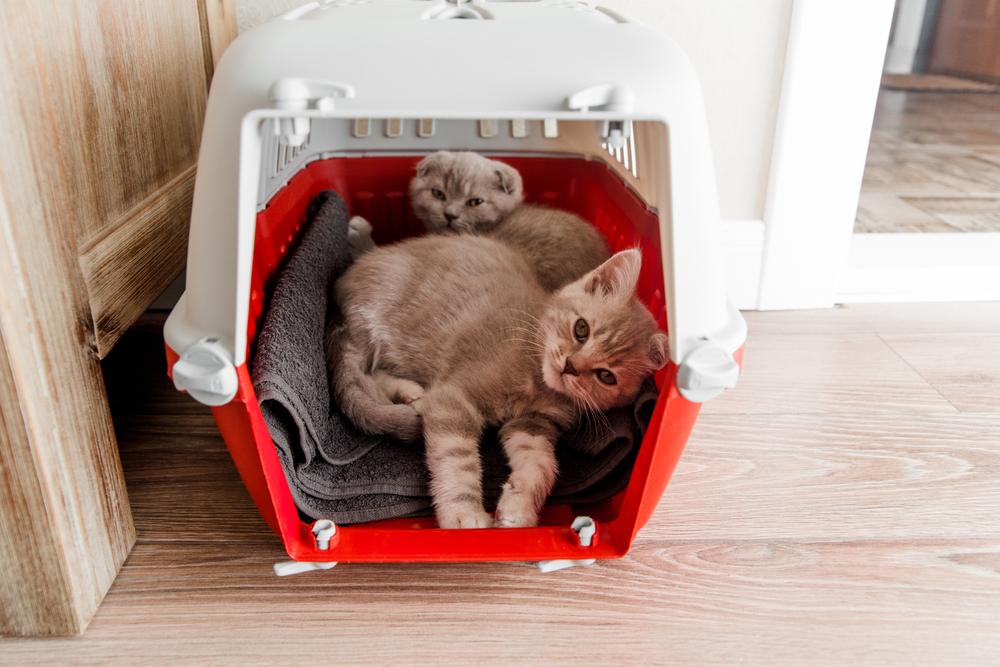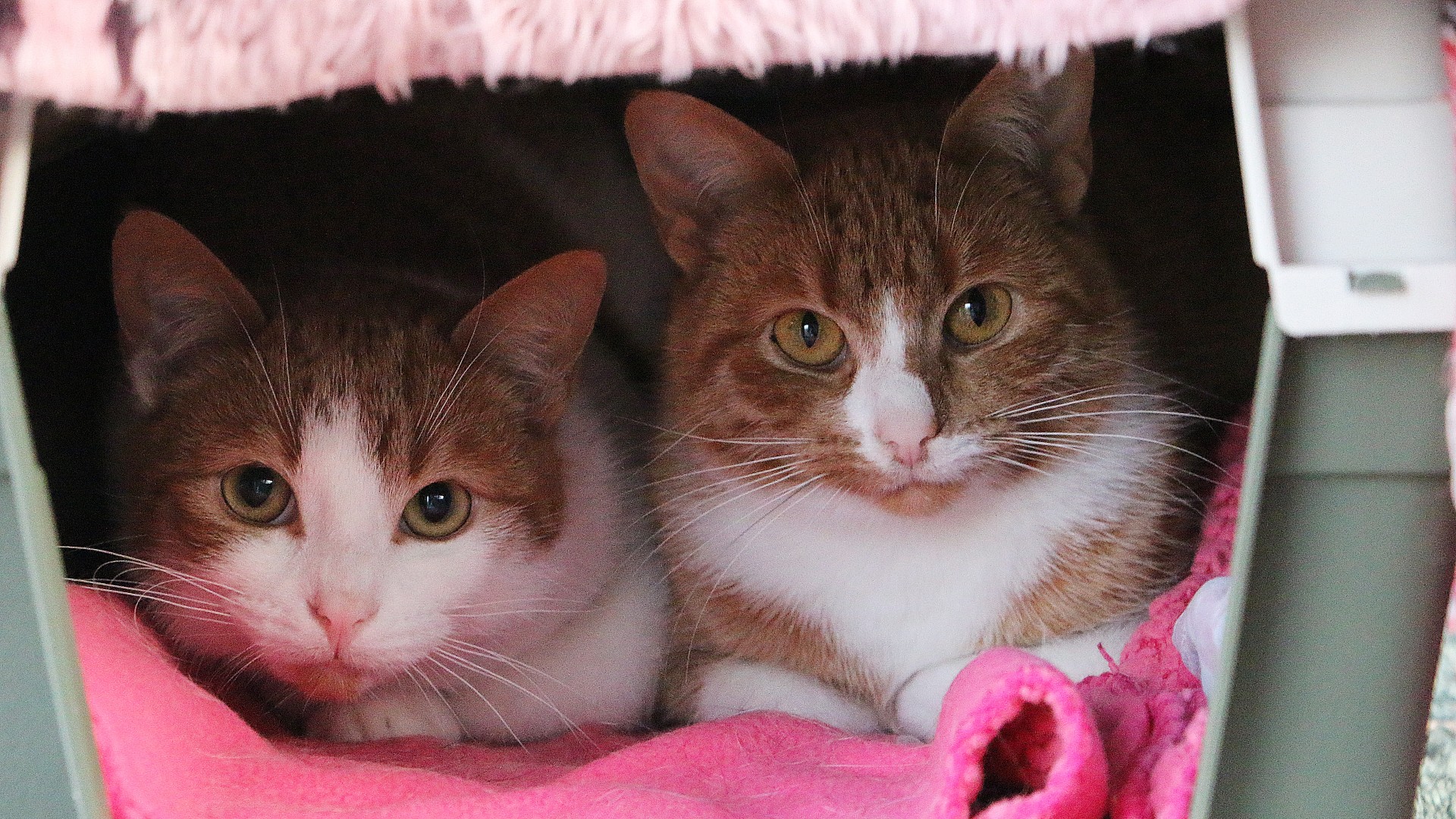Contents
- I. Introduction
- II. Why do people consider putting two cats in one carrier?
- III. Considerations when putting two cats in one carrier
- IV. Benefits of putting two cats in one carrier
- V. Risks of putting two cats in one carrier
- VI. How to safely put two cats in one carrier
- VII. Frequently asked questions about putting two cats in one carrier
- 1. Is it safe to put two cats in one carrier?
- 2. How do I introduce two cats to a carrier?
- 3. What if my cats fight in the carrier?
- 4. Should I sedate my cats before putting them in one carrier?
- 5. Can I use a soft-sided carrier for two cats?
- 6. How long can I keep two cats in one carrier?
- 7. Are there any alternatives to putting two cats in one carrier?
- 8. How can I make the carrier more comfortable for two cats?
- 9. Should I consult my veterinarian before putting two cats in one carrier?
- 10. How can I minimize stress when putting two cats in one carrier?
I. Introduction

Welcome to the world of cat carriers! If you are a cat owner, you may have wondered whether it is okay to put two cats in one carrier. This is a common question among pet owners who want to travel or take their feline friends to the vet together. In this article, we will explore the various factors to consider when deciding whether to put two cats in one carrier.
Cats are known for their independent nature, but they can also form strong bonds with other cats, especially if they have grown up together or have been introduced properly. However, when it comes to traveling or being confined in a carrier, some cats may become anxious or stressed.
Putting two cats in one carrier can have both advantages and disadvantages. One of the advantages is that it can provide a sense of security for the cats. Being together in a familiar space can help alleviate their anxiety and make the journey more comfortable for them. It also saves you the hassle of carrying multiple carriers and ensures that the cats stay together, which can be comforting for them.
Factors to consider
Before deciding to put two cats in one carrier, there are several factors you need to take into account:
1. Size of the carrier
Make sure the carrier is spacious enough to accommodate both cats comfortably. They should have enough room to move around, lie down, and stretch without feeling cramped. A carrier with multiple entrances and plenty of ventilation is also recommended.
2. Compatibility of the cats
If your cats get along well and have a history of being calm and relaxed together, they are more likely to tolerate sharing a carrier. On the other hand, if your cats tend to fight or exhibit territorial behavior, it might not be a good idea to put them in the same carrier.
3. Length of the journey
If you are planning a long journey, it is important to consider the comfort and well-being of your cats. If they are prone to getting stressed or agitated during travel, putting them in separate carriers might be a better option to avoid any potential conflicts or discomfort.
4. Training and acclimatization
Before attempting to put two cats in one carrier, it is essential to train and acclimate them to the carrier and the experience of being confined together. Gradually introduce them to the carrier, provide positive reinforcement, and monitor their reactions. If they show signs of distress or aggression, it is best to reconsider the plan.
Conclusion
Putting two cats in one carrier can be a viable option under certain circumstances, but it requires careful consideration of the cats’ personalities, compatibility, and the overall journey conditions. Always prioritize the safety, comfort, and well-being of your feline companions and consult with a veterinarian if you have any concerns or questions.
II. Why do people consider putting two cats in one carrier?

Putting two cats in one carrier is a practice that some pet owners consider when traveling or taking their furry friends to the veterinarian. While it may seem unusual to some, there are valid reasons why people opt for this approach.
Cats find comfort in each other’s presence
Cats are known for their independent nature, but they also enjoy companionship. When placed in a new or potentially stressful environment, having a feline friend by their side can provide a sense of security and comfort. Putting two cats in one carrier allows them to stay close to each other, reducing anxiety and promoting a calmer travel experience.
Convenience and ease of transport
Traveling with multiple cats can be challenging, especially if they are not accustomed to being in separate carriers. By putting them together in one carrier, it becomes easier to manage their transportation. It saves space, reduces the number of carriers needed, and simplifies the logistics of moving them from one place to another. This can be particularly beneficial for pet owners who do not have access to larger carriers or are limited by weight restrictions.
Some cats may exhibit stress-related behaviors when confined to a carrier, such as excessive vocalization, urination, or destructive scratching. However, when they are placed together, they often feel more secure and less prone to displaying these behaviors. The presence of a familiar companion can provide a sense of reassurance, making the overall travel experience less stressful for both cats.
Putting two cats in one carrier can also foster bonding and socialization between them. It allows them to spend quality time together, strengthening their relationship and creating a sense of unity. This can be particularly beneficial for newly introduced cats or those still developing a bond. By sharing a carrier, they have the opportunity to interact and engage with each other, promoting a harmonious relationship.
Creating a familiar environment
Cats are creatures of habit and thrive in familiar surroundings. Placing them in a shared carrier creates a sense of continuity, as they can rely on each other’s presence during the journey. It helps to maintain a semblance of their home environment, reducing the stress associated with being in an unfamiliar place. This can be especially important for cats with anxiety or those prone to motion sickness.
III. Considerations when putting two cats in one carrier

Putting two cats in one carrier can be a convenient solution when traveling or visiting the vet. However, it is important to consider a few factors to ensure the safety and comfort of your feline companions.
1. Size and type of carrier
When choosing a carrier for two cats, make sure it is spacious enough to accommodate both of them comfortably. Opt for a carrier with enough room for the cats to move around, stand, and lie down. A carrier with multiple compartments or a divider can provide separate spaces for each cat, reducing the potential for conflicts.
2. Familiarity and scent
Cats are highly sensitive to smells, so it is essential to introduce the carrier in a positive way. Place the carrier in a familiar and comfortable environment, such as their favorite room or near their beds. Add bedding or blankets with their scent to make the carrier more appealing and reassuring.
3. Gradual acclimation
Before attempting to put both cats in the carrier together, it is a good idea to familiarize them with the carrier individually. This can be done by leaving the carrier open in their living space and rewarding them with treats or praise when they explore or enter it voluntarily. Gradually increase the duration of their stays inside the carrier to help them feel more at ease.
4. Positive reinforcement
Using positive reinforcement techniques can help create positive associations with the carrier. Reward the cats with treats, praise, or playtime whenever they enter or remain calm inside the carrier. This will help reduce anxiety and make the carrier a more pleasant and less stressful experience for both cats.
5. Monitoring behavior
Observe the cats’ behavior and body language when they are in the carrier together. Look for signs of stress, aggression, or discomfort. If any signs of distress are observed, separate the cats immediately and provide them with separate carriers or travel arrangements.
6. Regular breaks
During long journeys, it is important to provide regular breaks for the cats. Allow them to stretch their legs, use the litter box, and have access to food and water. If the cats become agitated or show signs of distress during the journey, consider separating them temporarily to avoid potential conflicts.
Remember, each cat has its own personality and preferences, so it is essential to consider their individual needs when deciding to put them in one carrier. By following these considerations, you can ensure a safer and more comfortable travel experience for both of your beloved feline companions.
IV. Benefits of putting two cats in one carrier

Putting two cats in one carrier can have several benefits, both for the cats and their owners. Here are some advantages to consider:
1. Reduces stress and anxiety
Having two cats in one carrier can help alleviate their stress and anxiety during travel or vet visits. Cats are social animals, and being together in a confined space can provide them with a sense of security and comfort. They can groom and cuddle each other, which aids in reducing anxiety levels.
2. Promotes bonding
Sharing a carrier allows the cats to spend quality time together, fostering a stronger bond between them. This is especially beneficial for cats that are new to each other or have had a rocky relationship. It provides them with an opportunity to build trust and establish a positive association with each other.
3. Easier transport
From a practical standpoint, putting two cats in one carrier makes transportation more convenient. It reduces the number of carriers needed, making it easier for the owner to handle and monitor their cats during travel. It also saves space, which can be particularly useful when traveling by car or plane.
4. Cost-effective
Using a single carrier for both cats can help save money. Buying two separate carriers can be expensive, especially if you only occasionally need to transport both cats together. By utilizing one carrier, you can allocate your budget towards other essential pet supplies or services.
5. Simplifies vet visits
When visiting the vet, having two cats in one carrier simplifies the check-in and check-out process. It eliminates the need to juggle multiple carriers, making it easier to handle paperwork, medications, and other necessary items. It also streamlines the process for the veterinary staff, allowing them to focus on providing proper care to your cats.
Remember, before putting two cats in one carrier, ensure that the carrier is large enough to accommodate both cats comfortably. It should provide enough space for them to move around, lay down, and turn without any restrictions. Additionally, always monitor their behavior and ensure they are not showing signs of discomfort or aggression towards each other.
V. Risks of putting two cats in one carrier
When it comes to traveling with our feline companions, it’s natural to want to save space and put both cats in one carrier. However, there are several risks associated with this practice that cat owners should be aware of.
1. Increased stress and anxiety
Cats are highly territorial creatures and tend to become stressed when confined in small spaces with other cats. Putting two cats in one carrier can lead to increased stress and anxiety for both cats, as they may feel threatened and overwhelmed by each other’s presence.
2. Aggression and fighting
Sharing a carrier can escalate tensions between cats, especially if they have a history of aggression or territorial disputes. The close proximity in a confined space can result in fights and injuries, posing a significant risk to both cats.
3. Escape attempts
When two cats are placed together in a carrier, they may try to escape or break free from the carrier out of fear or discomfort. This can lead to accidents or injuries if the cats manage to open or damage the carrier during transit.
4. Increased risk of injury during travel
Traveling can be a stressful experience for cats, and putting two cats in one carrier increases the risk of injury during transit. If the cats start fighting or panicking, they may inadvertently hurt themselves or each other, potentially leading to serious injuries.
5. Lack of proper ventilation
Sharing a carrier can limit the airflow and ventilation, increasing the risk of respiratory problems for both cats. Proper ventilation is crucial to ensure the cats have access to fresh air and prevent them from overheating or suffocating.
It’s important to prioritize the well-being and safety of our furry friends when traveling. Instead of putting two cats in one carrier, it’s recommended to provide each cat with their own carrier to ensure their comfort, reduce stress, and prevent potential conflicts or injuries. By providing separate carriers, you can also monitor each cat’s individual needs and make necessary accommodations during the journey.
VI. How to safely put two cats in one carrier
If you have multiple cats and need to transport them together, putting them in one carrier can be a convenient option. However, it is essential to introduce them to the carrier gradually and ensure their safety throughout the process. Here are some steps to follow:
1. Choose a spacious carrier
First, make sure you have a carrier that is large enough to comfortably accommodate both cats. It should have enough room for them to stand, turn around, and lie down without feeling cramped. A carrier with multiple entrances can also be helpful.
2. Familiarize them with the carrier
Start by leaving the carrier open in a familiar and quiet space where your cats spend most of their time. Allow them to explore and get comfortable with the carrier at their own pace. You can place treats or toys inside to encourage them to enter and associate positive experiences with the carrier.
3. Gradually introduce the cats to each other
If the cats are not already familiar with each other, it’s important to introduce them gradually before attempting to put them in the carrier together. Allow them to interact in a controlled environment, such as a neutral room, while supervised. This will help them establish a sense of familiarity and reduce any potential stress or aggression during the carrier introduction.
4. Use calming pheromones
Consider using synthetic feline pheromone sprays or diffusers in the carrier and the surrounding area. These pheromones can help create a calming environment and reduce anxiety for both cats. Consult with your veterinarian for recommendations on suitable products.
5. Place each cat in the carrier separately
When the cats are comfortable with the carrier and have developed a positive association with it, you can start placing them inside individually. Place one cat in the carrier and secure the door before introducing the second cat. This prevents any potential escape attempts or aggressive behavior between the cats.
6. Provide comfort and distractions
Make the carrier a comfortable and inviting space by adding familiar bedding or clothing with your scent. Provide each cat with their favorite toys or treats to keep them occupied during the journey. This can help alleviate stress and make the experience more enjoyable for both cats.
Remember, patience is key when introducing cats to each other and acclimating them to a carrier. Monitor their behavior throughout the process and make adjustments as needed to ensure their safety and well-being. With proper preparation and gradual introduction, you can safely transport two cats in one carrier.
VII. Frequently asked questions about putting two cats in one carrier
Here are some common questions that cat owners often have when it comes to putting two cats in one carrier:
1. Is it safe to put two cats in one carrier?
Yes, it can be safe to put two cats in one carrier, but there are some factors to consider. The carrier should be large enough for both cats to comfortably fit inside without feeling cramped. It’s important to choose a sturdy carrier with secure latches to prevent any escapes during transportation.
2. How do I introduce two cats to a carrier?
Introducing two cats to a carrier requires patience and a gradual approach. Start by placing the carrier in a familiar and comfortable area for the cats. Allow them to explore the carrier at their own pace, using treats or toys to create a positive association. Gradually increase the time spent in the carrier until they are comfortable being inside together.
3. What if my cats fight in the carrier?
Cats may display territorial behavior or feel stressed when confined together in a carrier. To prevent fights, ensure that each cat has its own space within the carrier, with separate bedding and access to food and water. If the cats still exhibit aggressive behavior, it may be best to transport them in separate carriers to avoid any injuries.
4. Should I sedate my cats before putting them in one carrier?
Sedating cats should only be done under the guidance of a veterinarian. It is generally not recommended to sedate cats for travel unless there are specific medical reasons. Sedation can affect their balance and coordination, making them more susceptible to injury. Always consult with your vet before considering sedation for your cats.
5. Can I use a soft-sided carrier for two cats?
A soft-sided carrier can be used for two cats, as long as it is large enough and has proper ventilation. Soft-sided carriers are lightweight and easier to transport, but they may not provide as much protection as a hard-sided carrier. Ensure that the carrier is secure and has reinforced seams to prevent any escape or damage.
6. How long can I keep two cats in one carrier?
The duration of keeping two cats in one carrier should be minimized, especially for long journeys. Cats can become stressed or anxious when confined for extended periods. If traveling long distances, provide regular breaks where the cats can stretch, use a litter box, and have access to food and water. It’s essential to prioritize their comfort and well-being during travel.
7. Are there any alternatives to putting two cats in one carrier?
If putting two cats in one carrier is not feasible or causes undue stress, there are alternative options. You can use separate carriers or consider other means of transportation, such as using a pet-friendly car or hiring a professional pet transport service. The goal is to ensure the safety and comfort of your cats during travel.
8. How can I make the carrier more comfortable for two cats?
To make the carrier more comfortable for two cats, you can add soft bedding, familiar items with their scent, and toys to keep them entertained. Providing a cozy and secure environment will help reduce their anxiety during travel. Additionally, placing the carrier in a quiet and well-ventilated area can further enhance their comfort.
9. Should I consult my veterinarian before putting two cats in one carrier?
It is always recommended to consult with your veterinarian before putting two cats in one carrier, especially if they have any health concerns or behavioral issues. Your vet can provide specific advice based on your cats’ individual needs and help ensure a safe and stress-free travel experience.
10. How can I minimize stress when putting two cats in one carrier?
To minimize stress when putting two cats in one carrier, it’s important to plan ahead and create a positive environment. Gradual introductions, familiar scents, and keeping the carrier clean and comfortable can all contribute to reducing stress. Additionally, using calming pheromone sprays or consulting with a professional animal behaviorist can provide further guidance on stress reduction techniques.

Jackson is an accomplished content writer with a flair for captivating storytelling. With a Bachelor’s degree in English Literature from the prestigious University of California, Berkeley, Hunter’s educational background has honed his writing skills to perfection. His love for felines is evident in his extensive knowledge of cat behavior and care, making him an expert in the field. Hunter’s passion for cats has led him to contribute insightful articles to various online platforms, providing valuable information and tips to cat owners worldwide. With his exceptional writing abilities and deep understanding of cats, Hunter continues to create engaging content that resonates with readers and leaves a lasting impact.

